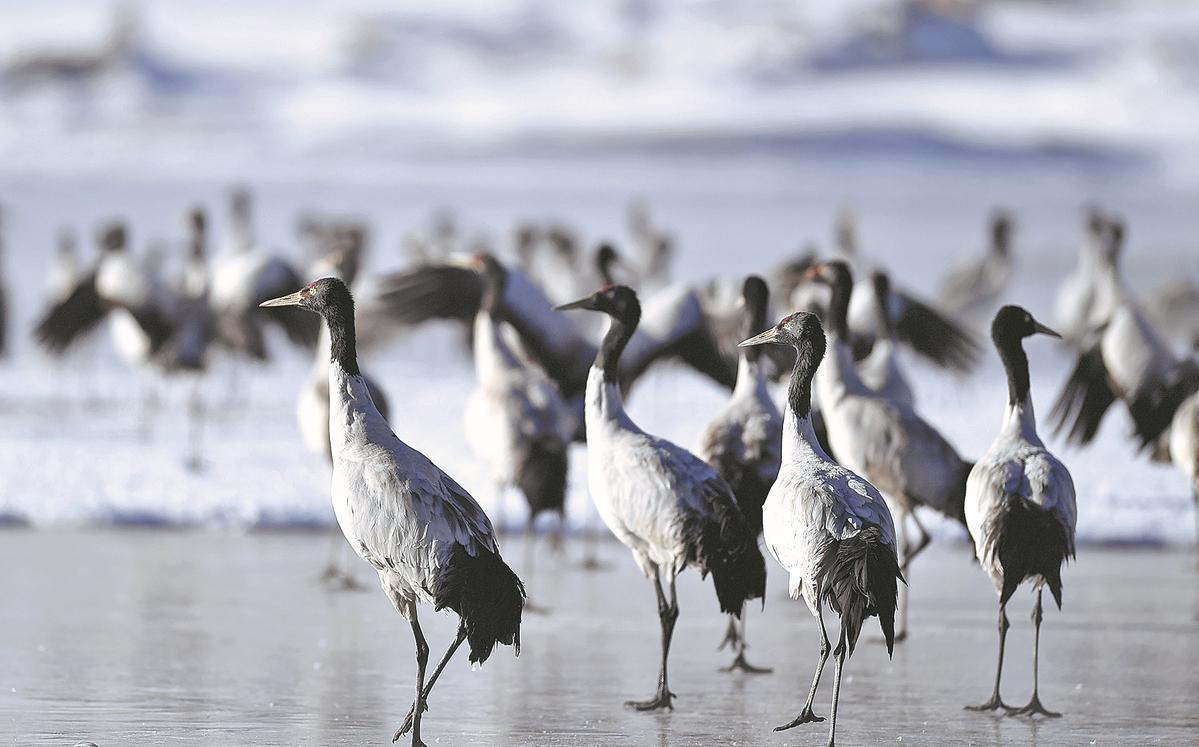Rare black-necked cranes can count on Tibetan villager for protection in winter

Black-necked cranes winter in Lhundrub county in the Tibet autonomous region on Feb 22, 2022. JIANG FAN/XINHUA
As the distant snow-capped mountains are bathed in the early morning light, the sound of ruddy shelducks and black-necked cranes fills the area as they search for food in the fields of Lhundrub county in the Tibet autonomous region.
At around 8 am, wildlife ranger Tenzin dons his jacket with the red armband and takes off on his motorbike to check on the birds.
He is one of nine patrolmen employed by the local forestry and grassland bureau to protect wildlife in the area.
As a first-class nationally protected species, the crane is also categorized as vulnerable by the International Union for Conservation of Nature, and the Tibetans regard the birds as harbingers of prosperity and auspiciousness. "I am very proud the black-necked cranes have chosen my hometown as their habitat. The villagers think they're glorious," Tenzin said.
Provided with a limited monthly subsidy by the bureau, he said protecting the rare birds is not just a job, but also a mission of the heart.
During the winter, Tenzin patrols daily to make sure the cranes have not been harmed or disturbed by people or stray dogs.
As he makes his rounds, he enjoys watching all sorts of birds, but especially the cranes.
"I am pleased and proud to protect black-necked cranes, and I've treated them as if they were my own children over the last decade," chinanews.com quoted Tenzin as saying.
He said that he has saved the lives of four cranes during that time, and even taken care of an injured bird at home for eight months.
"I spent a lot of time with the crane, so when the day came to release it back into the wild, I became very emotional," he added.
Located in Khardong village in Tsodo township, Tenzin's hometown is dotted with open farmland and a huge reservoir and is surrounded by mountains, which makes it a safe harbor for the birds.
Every year around October, the cranes migrate to winter in Lhundrub and then leave in March.
"As a result of increased protection over the last decade, the number of black-necked cranes has dramatically increased," he said, adding that the population in his village was less than 20 in 2013, but now 200 to 300 visit each year.
According to Tenzin, the increase is in part due to county government efforts.
Every year in mid-December, government workers deliver wheat to 10 feeding sites, as there isn't much else for the cranes to eat in the area. It is enough to see the birds through the winter.
During their stay, Tenzin protects the birds from dogs, but admits that it's a challenge, as the dogs run in packs and charge the birds from different directions when they attack.
Having been on patrol for years now, Tenzin is a master crane protector and rescuer.
Whenever villagers find an injured bird, they call him to come help.
His work is a reflection of the government's mission to protect wildlife in Tibet. Thanks to efforts over the years, the region's black-necked crane population has increased from fewer than 3,000 in 1995 to more than 10,000 today.
Since 2016, the regional government has created 700,000 environmental jobs for rural residents, increasing numbers of whom are being employed to work as wildlife rangers.
By DAQIONG and PALDEN NYIMA in Lhasa
